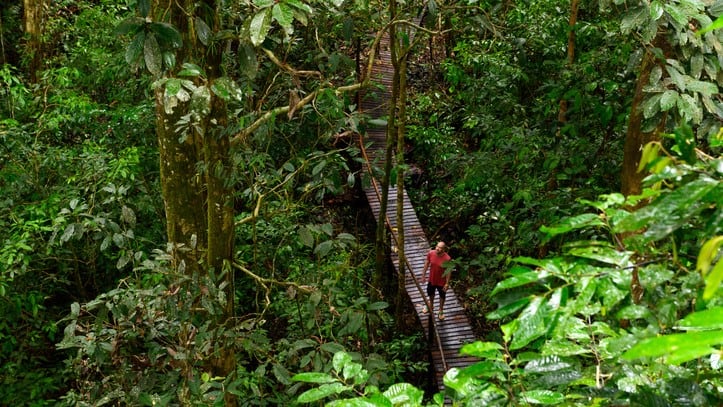The COP15 summit, attended by representatives from 188 governments, ended on 19 December 2022 with the adoption of the Kunming-Montreal Global Biodiversity Framework (GBF) – a plan to halt biodiversity loss and restore eco systems.
Besides addressing harmful subsidies, misdirected investment and unsustainable consumption and production and protecting indigenous rights, the framework included a pledge to raise international financial flows to developing countries to at least US$30 billion per year and to take measures to ensure that benefits arising from the utilization of genetic resources are shared equitably.
'Different' and 'remarkable' deal
These ambitions made the new framework “different” and “remarkable”, according to Inger Andersen, executive director of the UN’s Environment Programme (UNEP).
“The new GBF is remarkable because we know our means of implementation must be stronger, and that this includes more financing on the table, especially for developing countries. The new GBF is different because we know that we need to have the ability to do better in ensuring a fair and equitable share of the benefits we derive from genetic resources,” Andersen said in her closing statement at the end of the summit.
She added that protecting the natural world represented a “sum of many efforts”, from governments, businesses and individuals, and warned that “time is not on our side”.
What’s the plan? Four goals, 23 targets
The GBF set out four overarching global goals to protect nature: halting human-induced extinction of threatened species and reducing the rate of extinction of all species tenfold by 2050; sustainable use and management of biodiversity to ensure that nature’s contributions to people are valued, maintained and enhanced; fair sharing of the benefits from the utilization of genetic resources and digital sequence information on genetic resources; and making implementation accessible to all stakeholders, particularly least developed countries and small island developing states.
The framework also laid down 23 targets to achieve by 2030, including conservation and management of at least 30% of the world’s land, coastal areas and oceans (currently, 17% of land and 8% of marine areas are under protection); phasing out or reforming subsidies that harm biodiversity while scaling up positive incentives for biodiversity conservation and sustainable use; and mobilizing at least $200 billion per year from public and private sources for biodiversity-related funding.
Mind the investment gap
Indeed, a UN report released at the start of December, in the run-up to the summit, warned that climate, biodiversity and land degradation goals were out of reach at the current levels of investment in nature-based solutions.
The report indicated that if the world wants to halt biodiversity loss, limit climate change to below 1.5°C and achieve land degradation neutrality by 2030, current finance flows to nature-based solutions must urgently double by 2025 to US$ 384bn per year. And most of this additional investment would need to come from the private sector, it said.
“Governments currently provide 83% of nature-based solution finance flows yet will be unlikely to dramatically increase these flows due to fiscal challenges linked to conflict, debt and poverty. Therefore, the private sector must significantly increase investment from current levels of US$ 26bn (17%) per year.”
The private sector must increase investments in sustainable supply chains, reduce activities with negative impact on climate and biodiversity, offset unavoidable impacts through high integrity nature markets and invest in nature-positive activity, stated the report.
This echoed thoughts raised by British environmentalist Sir Jonathon Porritt at this year’s International Federation of Societies of Cosmetic Chemists (IFSCC) Congress in London, UK, last year, where he called upon the beauty industry to invest in driving ‘ethical integrity’ of entire supply chains amidst the ongoing climate crisis.
Time is of the essence
In her address at the start of COP15, Andersen emphasized the need for the plan to be delivered “in full, urgently and across all society”.
“The only possibility of achieving 2030 targets is with greater and more urgent action. Immediately after the gavel comes down, governments will need to set to work across all sectors, ministries and departments. Private sector, civil society, financiers, researchers, academics, indigenous people and local communities must lend their collective strength to implementing solutions. Food and agriculture systems, the timber industry, the chemicals industry, the buildings and construction industry and consumers – all must work with nature in tow,” she told delegates.
One target in particular that could require action from the beauty industry is the requirement for “transnational companies and financial institutions to monitor, assess, and transparently disclose risks and impacts on biodiversity through their operations, portfolios, supply and value chains”.
Underlining the urgency of the crisis, at COP15, 23 countries and organizations, led by Colombia and supported by Germany, launched a partnership to accelerate country-led implementation of the framework.
The Accelerator Partnership would facilitate access to financial and technical support, promote dialogue, outreach and knowledge exchange between countries. This would help countries fast track and upscale the implementation of their National Biodiversity Strategies and Action Plans (NBSAPs), said UNEP.
Actions will drive transformation
Despite the monumental scale of the biodiversity challenge, in Andersen’s statement at the closing press conference, she remained optimistic that, with urgent action, the relationship between people and nature could be transformed.
“I could go on about the litany of bad news we face. But we also know nature is very forgiving. If we give nature a chance, it will bounce back,” she said. “So, let us pause for but one second to embrace the history we have made in Montreal - and now let us get down to the business of delivering the Framework - for people and planet.”




